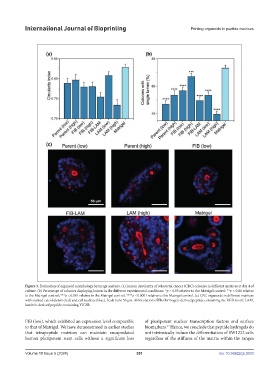Page 359 - IJB-10-5
P. 359
International Journal of Bioprinting Printing organoids in peptide matrices
Figure 3. Evaluation of organoid morphology by image analysis. (a) Lumen circularity of colorectal cancer (CRC) colonies in different matrices at day 4 of
culture. (b) Percentage of colonies displaying lumen in the different experimental conditions. *p < 0.05 relative to the Matrigel control; **p < 0.01 relative
to the Matrigel control; ***p < 0.001 relative to the Matrigel control, ****p <0.0001 relative to the Matrigel control. (c) CRC organoids in different matrices
with stained cytoskeleton (red) and cell nucleus (blue). Scale bars: 50 µm. Abbreviations: FIB, fibrinogen-derived peptide containing the RGD motif; LAM,
laminin-derived peptide containing YIGSR.
FIB (low), which exhibited an expression level comparable of pluripotent nuclear transcription factors and surface
to that of Matrigel. We have demonstrated in earlier studies biomarkers. Hence, we conclude that peptide hydrogels do
34
that tetrapeptide matrices can maintain encapsulated not intrinsically induce the differentiation of SW1222 cells
human pluripotent stem cells without a significant loss regardless of the stiffness of the matrix within the ranges
Volume 10 Issue 5 (2024) 351 doi: 10.36922/ijb.3033

